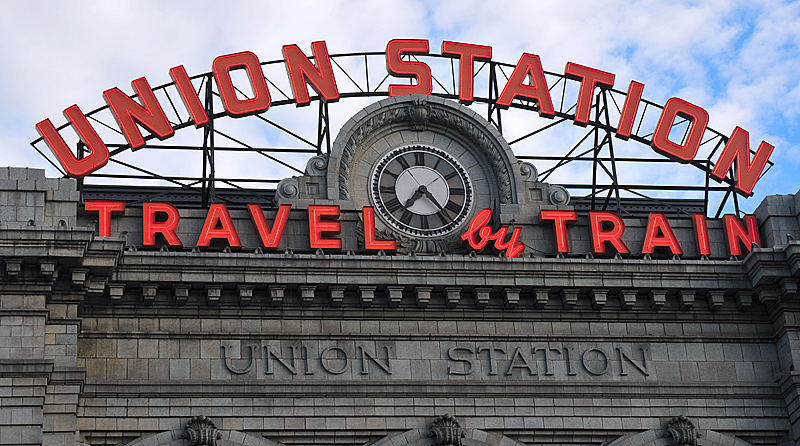







Alpine Tunnel station -- painting by Philip Ronfor as printed in Pictorial Supplement to Denver South Park & Pacific.
In a race with the Denver & Rio Grande, the Denver, South Park & Pacific built westward to what was anticipated to be a lucrative mineral market in Colorado's Gunnison region and perhaps beyond. Both crossings of the continental divide were difficult. The D&RG bought and build on Otto Mears' Marshall Pass toll road reaching an elevation of 10,842 ft (3,305 m); the DSP&P tunneled beneath the divide at Altman Pass (later known as Alpine Pass). The 1,772 foot long (540 m) Alpine Tunnel attained an elevation of 11,523 feet (3,512 m) at its apex.

Alpine Tunnel District map -- also from Pictorial Supplement to Denver South Park & Pacific.
The history of these two Colorado narrow gauge railways is a fascinating mix of competition, cooperation, bankruptcy and corporate intrigue involving Jay Gould and the Union Pacific. Construction techniques and facilities of the two roads were notably different.

The DSP&P station at Pitkin in use as a residence.
In an imprudent act of optimism, the South Park Line solicited contracts in October 1879 to do construction work of the tunnel under Altman Pass; contracts were signed in December specifying that the work was to be done in six months. At the time, South Park rails had not reached the Arkansas River.

Woodstock, site of "The White Death" in spring 1884. The tunnel station is just out of sight in the gap between mountains.
By November of that year, Jay Gould, who also played a major role in the Rio Grande, attained control of the South Park Line, but sold it the following January to Union Pacific which he also controlled. The South Park was now a feeder to the larger railroad.

Union Pacific's Colorado holdings. Map reproduced by Grahame Hardy.

The Lower Palisades. The stone wall was built without mortar.
Construction problems were greatly underestimated: the saddle rock under Altman Pass was mostly unstable decomposed granite; several streams of water flowed through it; winter weather was even more brutal than anticipated. The tunnel required a tight curve to enter from the east, and extensive timber lining was required because of the unstable rock. Things were not going as anticipated, and in July 1880, a new, more experienced contractor took over. Alpine Tunnel was holed-through in July of 1881, but much work remained to be done.

The old Williams Pass wagon road is the diagonal line crossing the railway grade.
The Denver & Rio Grande did not start their own route until 1880. But while the South Park struggled, the D&RG reached Gunnison in August of 1881.

Two substantial rock walls were built here by the South Park using no mortar. The technique was used again in the never completed Ohio Creek Extention (beyond Gunnison). be
It was not until September of 1882 that the first South Park train reached Gunnison having lost considerable business to its rival. The Gunnison district mineral business was disappointing, but ever optimistic, in October, the South Park began sleeping car service between Denver and Gunnison through Alpine Tunnel.

The Upper Palisades.
From the very beginnings, the tunnel route was plagued with unforeseen troubles. Problems during construction were just the beginning.

Alpine Tunnel Station looking through the remains of the enginehouse. The telegraph office and station has been restored. A boarding house was to the left of the station and a coal dock to the left of that.
On the snowy evening of March 10, 1884, an eastbound train had just departed Woodstock, 3.3 miles west of Alpine Tunnel, when an avalanche narrowly missed the train, but struck and destroyed the little town, killing most of the residents.

The station looking toward Gunnison.
A cave-in east of apex of the tunnel closed it to through traffic in 1888. For the next seven years, the South Park's traffic was rerouted over the D&RG's line.

Looking over the enginhouse remains. The tunnel portal (now collapsed) is at the end of the roadbed.
The DSP&P was reorganized in 1889 as the Denver Leadville & Gunnison.

Alpine Tunnel west portal. The timbers are remains of a snowshed at the entrance.
The UP had been in bankruptcy since 1893, and on November 18, 1898, the DL&G was sold at foreclosure for $1.5 million. DL&G became a part of the Colorado & Southern on December 28.

Alpine Tunnel Station from Altman Pass. I was there at the end of August 1974, and while hiking over the pass, it snowed.
In 1895, the tunnel reopened, but in June, while trying to use a locomotive inside the tunnel to siphon water accumulated between the apex and the rubble, carbon monoxide killed four men.

Looking down at the right-of-way on the Atlantic side.
The enginehouse at Alpine Tunnel Station burned in 1906.
In October 1910, still another cave-in struck Alpine Tunnel. Service ended permanently.

The east portal of Alpine Tunnel.
Ill conceived, ill fated, even cursed was Alpine Tunnel, but it definately qualifies as a railway legendary place. It has always been the most fascinating and scenic railroad crossing of Colorado's continental divide.